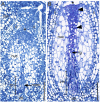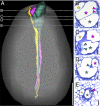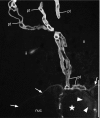Female gamete competition in an ancient angiosperm lineage
- PMID: 21690400
- PMCID: PMC3145725
- DOI: 10.1073/pnas.1104697108
Female gamete competition in an ancient angiosperm lineage
Abstract
In Trimenia moorei, an extant member of the ancient angiosperm clade Austrobaileyales, we found a remarkable pattern of female gametophyte (egg-producing structure) development that strikingly resembles that of pollen tubes and their intrasexual competition within the maternal pollen tube transmitting tissues of most flowers. In contrast with most other flowering plants, in Trimenia, multiple female gametophytes are initiated at the base (chalazal end) of each ovule. Female gametophytes grow from their tips and compete over hundreds of micrometers to reach the apex of the nucellus and the site of fertilization. Here, the successful female gametophyte will mate with a pollen tube to produce an embryo and an endosperm. Moreover, the central tissue within the ovules of Trimenia, through which the embryo sacs grow, contains starch and other carbohydrates similar to the pollen tube transmitting tissues in the styles of most flowers. The pattern of female gametophyte development found in Trimenia is rare but by no means unique in angiosperms. Importantly, it seems that multiple female gametophytes are occasionally or frequently initiated in members of other ancient angiosperm lineages. The intensification of pollen tube (male gametophyte) competition and enhanced maternal selection among competing pollen tubes are considered to have been major contributors to the rise of angiosperms. Based on insights from Trimenia, we posit that prefertilization female gametophyte (egg) competition within individual ovules in addition to male gametophyte (sperm) competition and maternal mate choice may have been key features of the earliest angiosperms.
Conflict of interest statement
The authors declare no conflict of interest.
Figures






References
-
- Crepet WL, Niklas KJ. Darwin's second “abominable mystery”: Why are there so many angiosperm species? Am J Bot. 2009;96:366–381. - PubMed
-
- Friedman WE. The meaning of Darwin's “abominable mystery.”. Am J Bot. 2009;96:5–21. - PubMed
-
- Stebbins GL. Flowering Plants: Evolution Above the Species Level. Cambridge, MA: Harvard University Press; 1974.
-
- Mulcahy DL. The rise of the angiosperms: A genecological factor. Science. 1979;206:20–23. - PubMed
-
- Endress PK. Syncarpy and alternative modes of escaping disadvantages of apocarpy in primitive angiosperms. Taxon. 1982;31:48–52.
Publication types
MeSH terms
LinkOut - more resources
Full Text Sources
Other Literature Sources
Miscellaneous

